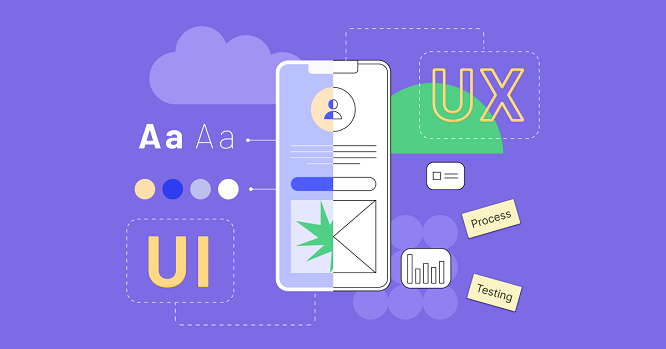UX vs. UI design: unraveling the crucial differences for digital product success

While the terms UI and UX are often used interchangeably, they describe two distinct yet essential aspects vital for crafting exceptional digital experiences. The User Interface (UI) concerns the visual elements with which users interact on a digital platform, including buttons, menus, navigation bars, and any graphic or text elements visible on the screen. User Experience (UX), on the other hand, encompasses the overall feel of the product and focuses on how satisfying and efficient it is for users to accomplish their goals.
UI designers are tasked with making sure that these visual components are aesthetically pleasing and functional. They work to create interfaces that are intuitive and easy to navigate, improving the user’s interaction with the application or website. They consider color schemes, typography, and layout to make the visual aspects of the digital product aligned with the user’s expectations.
Meanwhile, UX designers focus on the user’s journey through the application or website. They map out every possible interaction that a user might have with the product, from the initial engagement through to the completion of a task. UX designers use tools like user personas, wireframes, and usability tests. Their goal is to understand how users interact with the product and make strategic decisions to improve those interactions.
This guide aims to clarify the distinctions between UI and UX, highlighting how both roles are crucial to the success of digital products. It explores how UI and UX consulting services differ (here you can find out more and order the service), what each brings to a project, and how they work together to create products that are beautiful and functional. By understanding this, businesses and developers can better appreciate how these disciplines influence user satisfaction and product success. So, let’s explore these roles and their impact on the digital design.
Who is a UI designer?
UI designers are the wizards behind the digital curtain who conjure visually enchanting experiences for users. But what exactly does their mystical role entail?
The role
UI designers are storytellers who weave narratives through pixels and code. They’re the architects of user interfaces who craft intuitive layouts and captivating designs.
Key tasks
- Sketching wireframes
- Refining prototypes
- Collaborating with UX colleagues
- Translating user insights into designs
- Tweaking layouts for perfection
- Selecting color palettes
- Fine-tuning typography
Essential skills
Beyond artistic talent, UI designers require a set of skills to be successful in their role:
- A taste for aesthetics
- Problem-solving skills
- Mastery of design tools like, for example, Sketch or Figma
- Understanding of usability principles
- Proficiency in HTML, CSS, and other relevant technologies
- Good communication skills to collaborate with cross-functional teams
- Empathy for users, the ability to anticipate their needs and desires to create magical experiences
The role of UX designers
Ever wondered what makes your favorite app feel like a seamless digital dance? That’s the magic of UX design at play! Let’s peel back the layers and discover the secrets of this captivating craft.
The role
UX designers are the architects who sculpt the user experience with precision. Their mission is to understand the deepest desires and frustrations of users and then mold them into effortless interactions.
Key tasks
- Conducting user research
- Creating user personas
- Designing user flows and wireframes
- Prototyping and testing
- Iterating based on user feedback
- Collaborating with UI designers and developers
- Advocating for the user throughout the design process
Essential skills
UX designers should be armed with a versatile skill set that includes:
- Empathy for users
- Analytical thinking
- Proficiency in research methodologies
- Mastery of design and prototyping tools like Adobe XD or Axure
- Clear communication skills to convey complex ideas to different stakeholders
- Adaptability to evolving technologies and user needs
- A drive for improvement, always seeking ways to elevate the user experience to new heights.
UX design vs UI design
In UX design, the focus is on user-centricity. Through research and analysis, UX designers focus on understanding user behaviors, needs, and pain points. They craft user personas and map out detailed user journeys to inform design decisions. Their focus is on creating experiences that prioritize functionality and user satisfaction above all else.
UI designers are the visual storytellers of the digital world. They transform UX research insights into visually stunning interfaces that captivate users. They craft every pixel and select color schemes, typography, and visual elements to improve usability and create cohesive design systems. Their attention to detail makes sure that every interaction feels polished.
While UX and UI designers operate in distinct spheres, their collaboration is vital for digital product success. By bridging the gap between user experience and aesthetics, they create a symbiotic relationship that elevates the overall design.
In summary, the collaboration between UX and UI designers is crucial for crafting successful digital products. UX designers focus on understanding user needs and behaviors, making sure that the overall experience is intuitive and user-friendly. On the other hand, UI designers bring this vision to life by designing visually appealing interfaces that improve usability and engagement. Together, they form a cohesive team, using their respective skills to create digital experiences.
As technology advances and user expectations change, their collaboration remains essential in meeting changing user demands. By working together, they can create products that meet user expectations.





